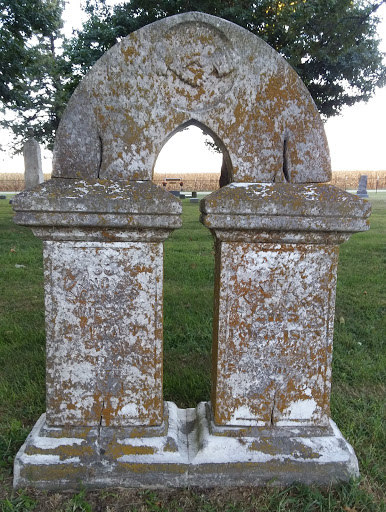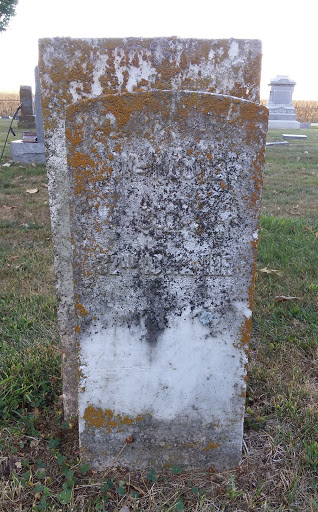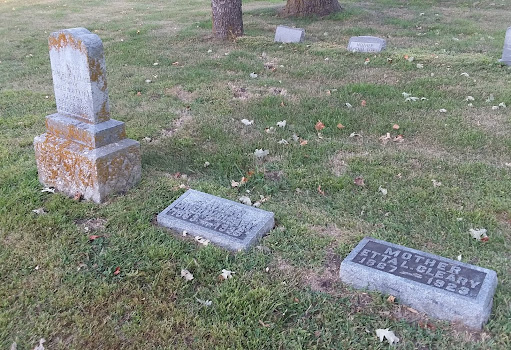Nestled just south of the tiny village of Irvington is a cemetery known as Laurel Hill. It is the final resting place of many well-known pioneers who came to Kossuth County with dreams of settling the frontier and becoming prosperous and successful. Many of their descendants, neighbors and others are buried there as well.
IRVINGTON CEMETERY ASSOCIATION
The Irvington Cemetery Association was organized June 26, 1875 by a group of prominent men who realized the necessity of having a resting place for the dead. Up to that time burials had been made at various places around the countryside. A constitution was adopted and the first officers were President A.M. Johnson, Vice President David Sample, Secretary G. M. Parsons and Treasurer Richard Hodges, all of whom now rest there in the shade of the majestic trees scattered throughout the cemetery.
On July 3, 1875, a tract of land was purchased from Mrs. Nancy Wright for $20. Beautifully located on high ground with good drainage, the land was bounded on the west by Des Moines River and timber land. A strip on the west side was reserved for those unable to buy lots. Mrs. Wright’s husband, Jacob, had passed away in February of that year and had been buried in this area. According to the cemetery records, burials had been made at the site for many years before it was designated as a cemetery.
The first annual meeting was held in September of 1875. A constitution of 29 articles was adopted. According to a news article published in the July 1, 1954 Kossuth County Advance, thirty-six charter members purchased one or more lots at $5 per lot. The cemetery consists of nine blocks with 24 lots per block. Each lot contains 9 burial spaces so, if you are following along and have done your math correctly, you will have figured out that they each got 9 burial spaces for $5! Quite a deal I would say.
Prior
to the establishment of the cemetery, people were often laid to rest on
acreages or in pastures. After the
cemetery was established, some of those bodies were recovered and brought to
Laurel Hill for burial. For example,
Abraham Knight died in 1861 of typhoid fever and was first interred in a field
in Sherman township. In 1890, his
remains were exhumed and buried here.
THE CEMETERY GROWS AND GAINS A NAME
In 1889, D.D. and Lydia Dodge deeded a strip of ground two rods wide extending along the entire length of the north line and a strip four rods wide along the west side of the cemetery, increasing it to the size it is today. The deed provided that the strip on the north was to be reserved for use as a public thoroughfare, however, the cemetery association reserved the right to erect and maintain hitching posts.
In 1916 the Association purchased a new fence and the Irvington Aid Society donated the north gate. Up until that time the cemetery had no name and it was left up to the Aid Society to choose one. The name of “Laurel Hill” was suggested by Etta Cleary. It is believed that it was named after a famous cemetery in Philadelphia with a riverside view. Etta Smith came to Kossuth County with her parents when she was 2 years old. She later taught school until she married Omer Cleary. The couple had one child, Charles, who contracted croup and died when he was just four years old. The Clearys lived in a home in this same section so Etta knew this area well. Now Mrs. Cleary is buried in the cemetery she named.
There are approximately 850 people buried there, some identified and others not. In 1922 construction workers were digging in the Irvington gravel pit when two skeletons buried in walnut caskets were unearthed. One news article of the time stated they appeared to be of an adult and a child. The theory was that they were the remains of Indians as some of the old settlers remembered there being an Indian burial ground in that area. That seems somewhat unlikely however because Indians did not normally bury their dead in wooden caskets. The remains were never identified, but were reburied here at the Irvington cemetery at the direction of the Kossuth County Board of Supervisors.
JACOB AND NANCY WRIGHT FAMILY
A unique
headstone marks the graves of Jacob and Nancy Wright, the original owners of
this land. The Wrights first came to
Kossuth County in 1855. The family was
here during the Indian scare and several family members participated in
building the fort which was erected at that time for protection. The fort was hastily constructed in April of
1857 based on inaccurate reports of sightings of bands of hostile Sioux
warriors nearby. Plans were made to take
the women and children to safety in Webster City while the men stayed back to
complete the fort and defend the little pioneer community.
 |
| Jacob and Nancy Wright Gravestone |
The Wrights’ daughter, Sarah, had become betrothed to William Moore, a carpenter and cabinet maker who had a combination home and workshop on one of the four corners of the main block in downtown Irvington. Sarah had no intention of traveling to Webster City and being separated from William. Since it would be inappropriate for a young, unmarried woman to remain behind, a wedding license was rapidly obtained. The couple was married by Justice of the Peace George D. Wheeler on April 22, 1857, at the home of her parents. Despite a heightened sense of danger, the locals in the community found time to celebrate the wedding and an evening of merriment was enjoyed by all. The next day the fort building continued and all of the women and children were taken to Webster City, with the exception of Sarah and her sister who remained and served as chief cooks for the garrison. It is interesting to note that the William Moore-Sarah Wright union was the first marriage to take place in the county.
William and Sarah settled in Irvington and started a family. We know that the couple had a daughter, Laura, who was born in 1860. When the War Between the States began, William enlisted on August 16, 1862 in Company A, 32nd Iowa Infantry. On December 30th of that same year, he died at Cape Girardeau, Missouri, of illness. His body was returned by the Army and buried here. Little Laura followed her father in death when she was but three years old and is buried next to him. We do not know what happened to Sarah Moore as the cemetery records do not reflect that she is buried here. Perhaps she married again and had another family, but that is a mystery not yet solved.
 |
| Gravestone of William Moore |
 |
| Gravestone of little Laura Moore |
As you will recall, Jacob Wright was buried here in 1875 before his wife, Nancy, sold the property for use as a cemetery. Nancy herself passed away in November of 1891 content that a permanent resting place had been designated. She was buried in the family plot marked with this distinctive headstone, surrounded by many of her neighbors and friends who had passed on to their eternal rest before her.
MANY VETERANS AT REST
There are numerous veterans buried in Laurel Hill from all branches of the military and all wars or conflicts from the Civil War forward. One lot contains the gravesites of three generations of veterans from the same family. John Haines was born in New York in 1824. At the age of 38 he enlisted in Company D, 126th New York Infantry and served throughout the Civil War. He was made a prisoner at Harper’s Ferry by Stonewall Jackson. After his release, he rejoined his company and was present at Appomattox when Lee surrendered. He came to Kossuth County with his family in 1870 and eventually pre-empted a claim in Garfield township where he resided until his death.
His grandson, Archie Haines, was drafted into WWI and was in the Kossuth County contingent that left September 22, 1917. Promoted to corporal before leaving the states, he was part of Company F, 350th Infantry that arrived in France in late August, 1918. By the following month they were stationed near the front. His company served in the trenches for several months before the war ended. During this time they slept wherever they could find rest—on the ground, in a box car, in a hayloft, or even standing in the trenches between rounds of shelling. His son, Orval, was born while he was overseas.
As I walk through a cemetery, I often think of the line from an old television show that went something like, “There are eight million stories in the naked city. This was just one of them.” There may not be eight million stories at Laurel Hill, but there are many waiting to be told. Each and every one of its residents had a unique and interesting life. I have touched on just a few in this post. Perhaps we will visit Laurel Hill again one day to hear other voices from the past.
Until next time,
Jean
If you
enjoyed this post, please don’t forget to “like” and SHARE to Facebook.
Not a Facebook user? Sign up with your email address in the box on
the right to have each post sent directly to you.
Be sure
to visit the KCHB Facebook page for more interesting info about the history of
Kossuth County, Iowa.
Reminder: The posts on Kossuth County History Buff
are ©2015-20 by Jean Kramer. Please use the FB “share” feature instead of
cutting/pasting.





My 2nd Gr GPA is Simon Shult who is buried in the Laurel Hill Cemetery. I have no info on how he ended up in the area. I wish I did!
ReplyDelete